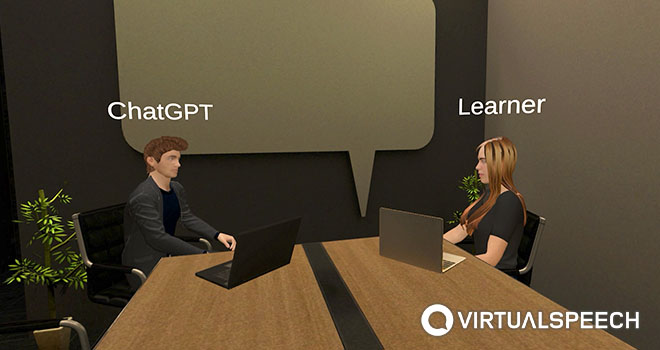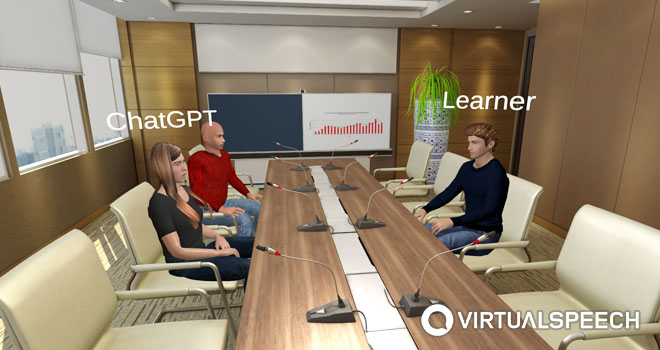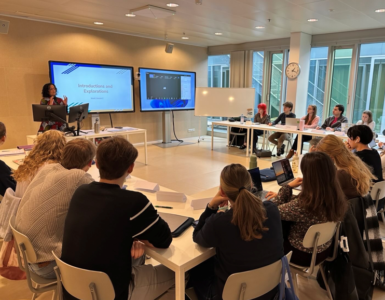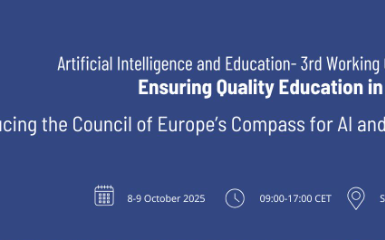by Sophie Thompson, VirtualSpeech, UK.
From interviewing for jobs or negotiating sales terms to fielding questions from the press or conducting disciplinary meetings – challenging and nerve-wracking situations arise in our working lives all the time.
Are we well prepared for them? Very often, no, not really.
No matter how many useful tips you read – when it comes to it, in order to be as well-prepared as possible, what you really need is practice and experience. It’s by actually living through these meetings, interviews and presentations that we learn, adapt, and grow.
But we need to develop these skills before the next event is upon us, and this is where ChatGPT and VR comes in!
Practicing in VR
By immersing yourself in a VR simulation of your upcoming meeting or event, you are able to practice within a scenario that is not only realistic but which also replicates the inevitable nerves and anxiety – making your practice far more stimulating and effective.
Adding ChatGPT to VR exercises
By adding in ChatGPT capabilities, VR training simulations are able to move to another level of interactivity. Within immersive 3D environments, VirtualSpeech are training avatars to interact directly with learners – thus allowing for complete two-way conversations between the learner and a simulated version of their interviewer, employee or client.
What is ChatGPT?
According to ChatGPT itself, ChatGPT (which is developed by OpenAI) is:
“…designed to generate human-like text based on a given prompt or context. It can be fine-tuned for a variety of tasks such as language translation, question answering, and text summarization. It can also be used for chatbot application, where it can generate human-like responses to user input.”
In other words, ChatGPT interacts in a conversational way. The dialogue format makes it possible for ChatGPT to answer follow up questions, admit its mistakes, challenge incorrect premises, and reject inappropriate requests – just like a human!
ChatGPT is a text-based tool but by using voice-to-text, and text-voice-to-voice technology, is a perfect partner for interactive experiences in VR.
Benefits of practicing with ChatGPT in VR
When it comes to practicing soft skills (interview technique, presentation skills, handling difficult conversations etc), the immersive environment of VR is an invaluable tool. VR allows for the next best thing to experiencing a live audience – yet it’s a safe space that allows for experimentation without fear of failure.
When we add in the ability to conduct meaningful two-way conversations, interviews and interactions (with ChatGPT) to this virtual platform, this training format becomes even more valuable as a tool for gaining real-world skills.
Below are some of the benefits of combining ChatGPT in a VR training platform:
- Enhanced engagement and immersion: ChatGPT functionality can provide users with a more engaging and immersive experience, as they interact with virtual characters that can respond in a human-like way.
- Personalized feedback and coaching: ChatGPT can be used to provide users with personalized feedback and coaching, as it can generate responses based on their actions and decisions.
- Scalability: VR and ChatGPT can be used to train large groups of people in a cost-effective and time-efficient manner, from anywhere in the world
- Accessibility: VR and ChatGPT can be used to provide soft skills training to people with disabilities or those who have difficulty accessing traditional training methods.
- Cost-effective: Using VR with ChatGPT can be less costly than traditional training methods, as it eliminates the need for travel, lodging, and other expenses.
- Access to realistic scenarios: VR and ChatGPT can provide access to realistic scenarios and interactions, which can help users to better understand and prepare for real-life situations by evoking an emotional response to their learning.
Examples of ChatGPT training use cases
VirtualSpeech has identified a number of our existing training scenarios where the learning experience can be enhanced with the addition of ChatGPT technology. Below are three examples.
Difficult Conversations: Performance review

One of the hardest parts of any manager’s job is giving negative feedback. A tough message must be communicated and understood – yet in order to be effective, the manager must demonstrate openness, respect and support. This is also a scenario where active listening skills should be put into practice, ensuring the concerns of the employee are heard.
These skills are not easy to practice alone – and ChatGPT in a VR immersive environment can help enormously. It works like this:
You enter your VR meeting room of choice and find yourself face-to-face with your employee. It’s the moment you’ve been dreading. You take a deep breath, greet your employee and begin the conversation; bringing up the key points you want to raise.
When your employee responds it’s not the response you were expecting. You are thrown for a moment, but regain your composure and continue the conversation until finally bringing it to a close.
Afterwards, using the VirtualSpeech feedback tools (including video playback, speech and eye-contact analysis) you are able to look back on your meeting and reflect on your performance. You can then re-run the entire meeting – where, this time, the conversation may take a completely different shape.
Job Interview: Answering questions

Everyone gets nervous about job interviews, yet for an interview to be successful it’s vital to come across calm and confident. As ever, practice is key – and with the addition of ChatGPT to VR simulated interview exercises, the most realistic practice is now attainable!
Rather than responding to pre-programmed questions (which certainly has its own value), it is now also possible to carry out real-time interviews where the avatar interviewer draws on your previous response to ask you follow-up questions.
As with all the VirtualSpeech practice exercises, after running your practice interview, you will have the opportunity to reflect on your performance. You’ll receive feedback in terms of tone, pace, eye contact etc and you’ll be able to watch the interview back for self-analysis before restarting the experience – where the questions will not be the same.
Presentation: Answering questions

Another great example of a practice exercise that has been enhanced by the use of ChatGPT is the question and answer session at the end of a presentation or press conference.
In VR, you can select your VR auditorium and an appropriate audience size to deliver your presentation to. During your speech, a mobile phone rings, the lights are too bright and some audience members start talking amongst themselves. You’re used to this because you practice regularly and your speech goes well! But now the hardest part begins: the dreaded question and answer session is upon you!
Previously with immersive learning, it’s been possible to pre-programme questions to practice with or to use AI to generate questions on specific topics. These are important and valuable features and will remain in the VirtualSpeech platform.
However, the ChatGPT functionality adds a further layer of sophistication to this practice exercise: the system listens to and understands the context of your speech, allowing your virtual audience to ask you questions related to what you have said.
The future of ChatGPT in VR
When it comes to soft skills, this powerful combination of immersive virtual reality with advanced, conversational artificial intelligence is exciting and will undoubtedly have an enormous impact on the way we learn. Practice and physical experience is the only real way to improve our soft skill sets – and, the more closely we can simulate the real world in a virtual environment, the more effective our practice will be.
Technology is moving at a rapid pace, and huge advances have been achieved in a very short space of time. It’s still early days and there are inevitably a few limitations to the current ChatGPT functionality – there is, for example, a necessary time delay in avatar response while ChatGPT composes its thoughts and the text-to-voice technology works its magic. However, these details are sure to improve at a rapid rate and are nothing that a sprinkling of imagination can’t overcome in the meantime.
A real-time two-way conversation with an avatar, who responds to your voice and gives you feedback was unthinkable for most of us just a couple of months ago. The value we can draw from VR and AI for our everyday lives in the real world is incredible – and where these technologies will take us in the future is mindblowing.
Editor’s note: This article first appeared on the VirtualSpeech blog.

Author
Sophie Thompson, CEO & Co-founder of VirtualSpeech














